Spring 2011 A publication of the Wildlife Division—Getting Texans Involved
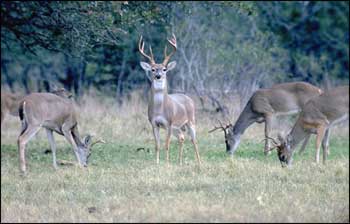 Managing for Wildlife Diversity
Managing for Wildlife Diversity
through Deer Population Control
By Kevin Schwausch
W ildlife diversity is a combination of the richness (number of different species) and the abundance of wildlife species that occupy a specific habitat. Diversity is important because habitats are more stable when a variety of plant and animal species fill different roles within those habitats, providing a buffer against negative impacts due to natural or human induced events. This is because most species are specialists, meaning that they fill a single or a few specialized roles. Diverse habitat will have many species of plants which will in turn support many wildlife species. For this reason habitat degradation, such as the loss of vegetation due to over browsing by deer, can cause wildlife species to decline or disappear.
Throughout the Texas Hill Country white-tailed deer populations have expanded to the point diversity is declining in many areas. In the early 1900's, deer populations in Texas were near 150,000. Hunting regulations, seasons, and bag limits brought deer populations back from the brink of extirpation and eventually these populations began to reach the carrying capacity of the land. Over-protection of the female segment of the population and the eradication of the screw worm, a major predator, along with changes in land use practices were the catalyst for dramatic increases in deer populations. Today, deer populations in the Texas Hill Country are in the neighborhood of one million and have significantly influenced the vegetation present today.
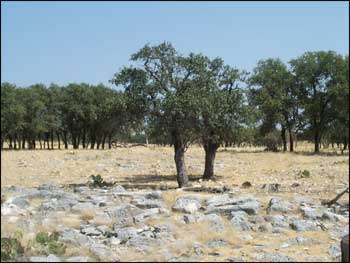
© Dale Prochaska
White-tailed deer are primarily browsers, that is, they eat the leaves and stems from woody plants like trees and shrubs. Browse species are the most stable and important component of the habitat because they are less susceptible to impacts from weather conditions such as drought, unlike other preferred forages such as forbs and mast crops which are rainfall dependent. Now to a deer (and most species) not all browse species and other plants are created equal. Some are more desirable than others for their palatability. Like us, they will readily eat the things that are tasty and leave the foods that are, like my 3 year old would say… "yucky." Several of the more desirable deer forages in the Hill Country include Texas oak, kidneywood, and cedar elm. On the other hand, species such as live oak, ashe juniper, and Texas persimmon are less desirable deer forages. Once the more desirable plants have been reduced (or removed) the less desirable are utilized more. With this in mind, habitat quality can be evaluated based on these factors.
By this time you are probably wondering how to evaluate habitat for indications of deer overpopulation and wildlife diversity. Well…most habitats in the Hill Country that are not under some deer population control are more than likely exceeding carrying capacity and thus reduced in diversity. An easy indication of habitat overutilization is the presence of a browse line. This is characterized by the lack of leaves on woody vegetation from the point as high as a deer can reach (about 4 - 5 feet) to the ground. Less noticeable indications of deer overpopulation would be reduced plant species diversity. When you are looking at the native range in the Hill Country, there should be a wide diversity of vegetation. When the habitat is dominated by just a few woody species (like the less desirable ones listed earlier) wildlife diversity is reduced.
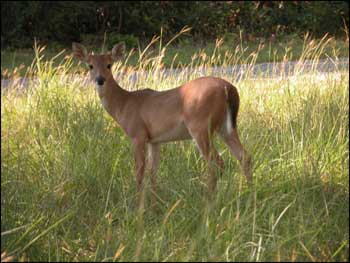
Texas has many methods to control deer populations on a localized ranch scale. First and foremost, hunting is the most readily available method to maintain white-tailed deer populations at carrying capacity of the native habitats. It merely requires a hunting license and landowner permission in order to begin. Hunting also can provide a source of revenue for the landowner which can in turn be used to improve the quality of the habitat for all wildlife species. Additional methods of deer population control include Managed Lands Deer Permit (MLDP), Antlerless-Spike Deer Control Permit (ADCP), Trap/Transport/Transplant (TTT) permit, Trap/Transport/Process (TTP) permit, and Depredation permit. Detailed information regarding the requirements and conditions of these permits can be found on the TPWD website at http://www.tpwd.state.tx.us/business/permits/
I do not want to leave the impression that controlling deer populations is simple nor do I intend that one need only to lower the deer population in order for the plant and wildlife diversity to instantly come back. It takes an extended period of time coupled with other management practices in order to recoup lost habitat and diversity. But if deer populations are not at or below the carrying capacity of the land, no matter what habitat improvement techniques you try, the vegetation will take much longer to recover, if at all.
For more information on how to maintain diverse wildlife habitats or deer population control methods please contact your local TPWD wildlife biologist (http://www.tpwd.state.tx.us/landwater/land/technical_guidance/ ). The TPWD technical guidance program provides technical assistance to landowners on a wide variety of wildlife management strategies.
Kevin is a Technical Guidance Biologist working out of Burnet, TX.
Texas Wild-rice:
Umbrella Species of the San Marcos River
By Jackie M. Poole
While adequate water is a necessity, too much water may make the river too deep or the current too swift for even the most tolerant organisms. Although floods are needed to refresh the system, if floods are too frequent or of biblical proportions, recovery and restoration may not be possible. Texas wild-rice grows best in water between 6 inches and 4 feet deep with a moderate current. It dies when water levels remain below 6 inches for more than a few days. When Texas wild-rice grows in still, shallow water, it flowers and disperses seeds while in deeper, swifter water, it remains submerged and reproduces vegetatively by rooting at the stem nodes. Having two reproductive strategies is a good plan for living in a constantly changing environment such as a spring-fed river in a semi-arid urban habitat.
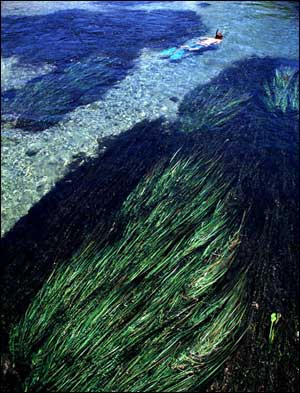
The upper San Marcos River, home to several endangered species, relies on springs of the Edwards Aquifer. In pre-European times, the springs were artesian, shooting water into the air over the free flowing river. Now there are several dams, including the Spring Lake dams that back up enough water to hide this former fountain. Creation of the lake and deeper water levels led to the extirpation of Texas wild-rice here. Two colonies have been reestablished in the shallower areas of the lake. Other dams on the upper San Marcos River have a similar effect, producing deep, sluggish pools where Texas wild-rice cannot grow.
Other changes to the river include habitat modifications such as dams and channelization (for example the concrete walled banks in Sewell Park); invasion by non-native plants and animals, both along the banks and in the river; intense recreation leading to unintentional harassment through trampling and uprooting vegetation; water pollution including abnormal sediment loads; and the most influential change, pumping of the Edwards Aquifer.
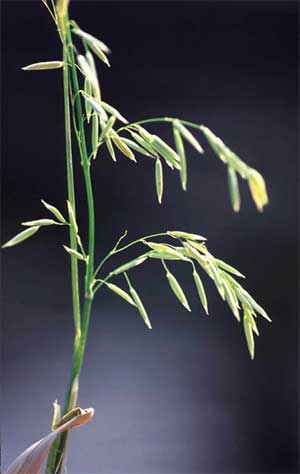
Water levels in the San Marcos River and the Edwards Aquifer naturally respond to climate, depending on the amount of precipitation that falls on the watershed. Various factors can modify how much of this precipitation actually gets into the river or aquifer. While high rainfall causes an immediate rise in the river, recharge of the aquifer takes weeks and can be affected by hard surfaces such as rock, pavement, rooftops, etc. that can cause run-off to be too swift to percolate into the aquifer. During drought the levels of the river and the aquifer fall. This is exacerbated by aquifer pumping for urban, industrial, rural, and agricultural needs.
Due to the high number of endangered species in the San Marcos River as well as recreational uses of the river and the necessity to have water continue to flow downstream to the bays and estuaries of the Gulf, there is a need to balance the water requirements of all these species and people. The U.S. Fish and Wildlife Service with the assistance of the Texas Legislature through Senate Bill 3 implemented the Edwards Aquifer Recovery Implementation Program, a group of stakeholders from all affected groups to work together to achieve a solution to the water allocation problem. After almost three years the program has determined the flow requirements for the endangered species, water management that would allow adequate flows for the endangered species survival and increase, and various mitigation measures that would protect the species during times of extreme drought. For Texas wild-rice this would require restoring wild-rice to as much suitable habitat as possible without removing native species, keeping floating mats of vegetation and debris off wild-rice at all times, and developing a recreation plan that would address river access points, safe sites for wild-rice, and ways to route recreational traffic around wild-rice, especially during times of low flow.
We all need to plan ahead for rainy days and have our umbrellas functional and in good repair. But we also need to have good functional umbrellas like Texas wild-rice that protect us and the San Marcos River during times of drought and keep the San Marcos free flowing.
Jackie Poole is a botanist with the Wildlife Diversity Program at Texas Parks and Wildlife Department working out of Austin.
Edwards Aquifer Endangered Species Protection
By Cindy Loeffler
Conflict over the Edwards Aquifer has been brewing for decades and was brought to head in 1991 when the Sierra Club filed a lawsuit under the federal Endangered Species Act that resulted in the creation of the Edwards Aquifer Authority (EAA). The Texas legislature directed the EAA to regulate pumping from the aquifer, implement critical period management restrictions, and ensure minimum continuous springflows of the Comal and San Marcos Springs. Since that time, attempts to manage the Edwards Aquifer to balance pumping with species protection have been contentious and difficult, to say the least. The EARIP was initiated by the United States Fish and Wildlife Service in 2006 and modified by the Texas legislature through Senate Bill 3 in 2007 to create a collaborative process that includes a diversity of stakeholders representing local and state governments, river authorities, environmental interests, recreational and public interest groups, agriculture and industry interests, groundwater and surface water developers and users, and universities.
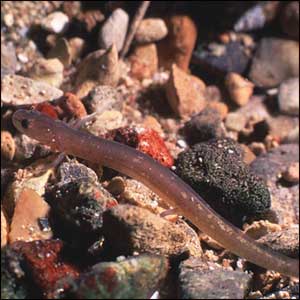
There are a handful of other Recovery Implementation Programs underway in the United States, but they all deal with particularly complex conservation issues that often include water. Due to the complexity of the issues, RIP processes often take many years to complete and must rely not only on scientists and engineers but also on attorneys and other experts to be successful. TPWD participation in the EARIP is extensive with participation from the Water Resources Branch, Legal Division, Coastal Fisheries Division, Inland Fisheries Division, and the Wildlife Division.
The EARIP Science Subcommittee (SSC), which was appointed by the EARIP Steering Committee and includes three TPWD Scientists, was directed by SB3 to address specific charges including species requirements in relation to spring discharge rates and aquifer levels as well as pumping reductions and stages for critical period management associated with species requirements. In its peer-reviewed December 2008 report, the SSC recommended springflow regimes necessary for the long term survival of aquatic communities of Comal and San Marcos Springs. These recommendations are intended to ensure the survival and recovery of federally listed endangered species in the wild and are based on assumptions that current conditions would exist regarding invasive species control, management of recreational impacts, sediment management, and parasite control. The EARIP has also retained several technical consulting teams to support analysis of groundwater management alternatives, habitat modeling and ecological restoration options.
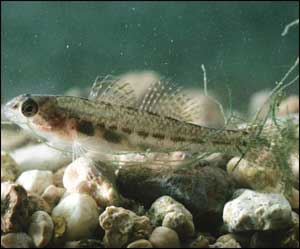
For the past three years the Steering Committee has been working on strategies to for protecting springflows, especially during extreme drought periods. The package of options has been coined the "Bottom Up" approach because it sets forth an incremental, phased approach to reduce aquifer pumping, increase ecosystem restoration measures and to monitor progress of these actions. Key measures for reducing aquifer pumping include increased conservation by smaller communities, an innovation called Aquifer Storage and Recovery (ASR), voluntary suspension of irrigation pumping during drought and additional mandatory Critical Period pumping restrictions. Ecosystem restoration measures include habitat restoration, exotic species management and recreation management. There are still many unknowns, primarily because the severity of future droughts and associated ecosystem impacts cannot be predicted. To help address this uncertainty the incremental, phased approach allows for adaptive management and the ability to adjust protection measures in the future. The "Bottom Up" approach also includes provisions for enhancing the ability to protect species in refugia if a drought worse that predicted does occur.
The estimated cost of the "Bottom Up" package is $30 million/year. Recently the EARIP Steering Committee approved a proposal to fund EARIP activities that would include a regional sales tax. Alternative funding mechanisms will also be explored. If approved by local voters, the money collected would be used to implement the EARIP and to fund other water issues related to species of concern in the region, with first priority going to EARIP implementation. There is interest among members of the Steering Committee to try to address other similar water-related endangered species issues, most notably whooping cranes.
The final product of the EARIP will be a plan to protect the federally listed endangered or threatened species while managing the use of the Edwards Aquifer. This plan is to be completed by September 1, 2012. For more information on the EARIP visit http://earip.org/.
Cindy Loeffler is Water Resources Manager at Texas Parks and Wildlife Department working out of Austin headquarters.
Conservation, Landowners,
Government and Real Estate
By Andy Winter
Under the Endangered Species Act (passed in 1973), anyone wishing to remove habitat containing an endangered species must develop a mitigation agreement, usually called a Habitat Conservation Plan, in coordination with the U.S. Fish & Wildlife Service. That Plan would outline how and where habitat loss would be mitigated. To comply with the law, a construction project would typically require 3 years worth of field surveys, and an additional 2-4 years to develop a mitigation strategy, write the plan, and negotiate with state and federal regulators. When time is money, and when money is short, 7 years of delay, and 7 years worth of legal and environmental consultant fees doesn't do much for the local economy. Many times, conservation becomes the afterthought that few are willing to pay for.
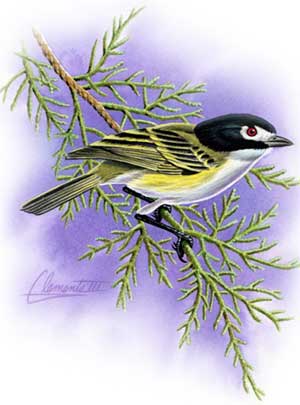
Artwork by Clemente Gusman III
Enter the Regional Plan.
Instead of asking each development project to negotiate an expensive and time-consuming Habitat Conservation Plan, communities have the ability to develop an umbrella plan for construction projects called a Regional Habitat Conservation Plan (RHCP). An RHCP is a federal permit that provides a more efficient mechanism for developers and communities to comply with the Endangered Species Act. Under this plan, none of the requirements of the Endangered Species Act are changed or diminished. An RHCP is issued by the USFWS to an entity that covers a wide geographic area, such as a county or group of counties. That entity then issues subpermits to anyone that wants to adversely affect sensitive habitat. In exchange, the subpermittee pays a participation fee to the permit holder that is used to acquire or protect land somewhere else as mitigation. The process typically takes about 3 weeks. While the participation fee may be more than what would have been required with an individual HCP, the participant saves years of time and money required to develop their own plan.
Community leaders in the City of San Antonio, Bexar County, and several outlying counties are developing the Southern Edwards Plateau Regional Habitat Conservation Plan (SEP-HCP). Centered on the growth sectors of San Antonio, and the possible growth of Kerrville, Boerne, Castroville, and Johnson City, the SEP-HCP will provide for economic growth and development of thousands of acres of hill country habitat, while simultaneously providing both the funding mechanism and the infrastructure to protect tens of thousands of acres for conservation.
Enter the people
Final details of the plan have yet to be decided, but both a Citizen's Committee and a Science Committee have been working since October 2009 to create a structure amenable to the interests of the conservation community, private landowners, local government representatives, and the real estate community. In fact, each of those groups were asked and agreed to participate in the planning process, and meet at least monthly to develop a workable solution. Thus far, they have set admirable goals of assisting 9 listed species: 2 songbirds and 7 endangered cave invertebrates within an area that includes the major growth sectors of this region. All of the people involved want to ensure that public input is collected and private property rights are respected. In fact, the process is legally mandated to ensure that land containing endangered species or endangered species habitat is not devalued through plan actions. Public meetings will be held in April 2011 to get feedback from local residents.
Enter the concerns
The SEP-HCP does not give anyone the authority to condemn land, nor does it make the condemnation process either. In fact, it has absolutely nothing to do with land condemnation. It deals solely with removing barriers to compliance with the federal Endangered Species Act. The SEP-HCP does not alter or diminish the restrictions of the ESA or state regulations concerning wildlife management.
Additionally, the SEP-HCP will not require anyone to participate. The administrators of the plan will interact only with voluntary participants. The citizens developing the SEP-HCP are intent on providing private landowners only additional choices in the management of their property. If a landowner in the Plan Area wants to sell to a neighbor, a developer, or anyone else, he or she is free to do so.
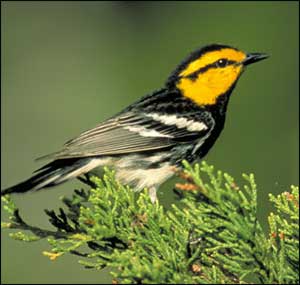
© Steve Maslowski, US Fish and Wildlife Service
If a landowner thinks they might have endangered species on their property, with the SEP-HCP, they will have the option to get paid for protecting that commodity. Certainly conservation easements have been around a while, but the legal and time constraints often overwhelmed even the most willing participant. The SEP-HCP will create a streamlined process for the landowner to be compensated for protecting sensitive hill country habitat. As in other conservation easements, landowners that accept compensation for land protection measures will still retain the ability run livestock, family or lease hunt, and buy or sell land. And the plan only deals with willing participants, so nobody is required to participate, regardless of what their neighbors do or don't do.
Return of the Warbler
I checked up on that brave male warbler at the end of the breeding season. As it turns out, a successful nest was documented close by. The young fledged successfully and the chipper song of the male is expected back this spring. Perhaps the SEP-HCP, like that male warbler in an island of urban expansion, is an indication that central Texas can find a balance between growth and responsible stewardship of even our most sensitive neighbors.
Andy Winter is Bexar County Environmental Engineer and coordinator of the Southern Edwards Plateau Habitat Conservation Plan.
Book Reviews
Review by Mike Krueger
It's fortunate that Jim Stanley took the time to write the Hill Country Landowners Guide so that his knowledge can be shared with his primary target audience - new owners of Hill Country property, many of whom may have little if any experience in managing a piece of central Texas rangeland. But even those landowners who have been here a while and think they know a thing or two about taking care of their property can benefit from this book that is written in an easy, conversational style by one of their own. Jim acknowledges that he also was new to the land not that long ago, and experienced many of the same trials and tribulations that many of them most likely are experiencing. He has learned through experience, research, and lots of reading, attending classes, and consultations with experts in their fields to overcome many of the land stewardship challenges.
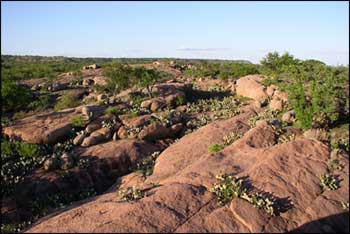
The book is segregated into several easy-to-digest sections. The first few chapters provide a very good background on what the Hill Country landscape likely looked like prior to settling by European man, why it looks the way it does today, and the challenges faced by the current owners of pieces of that landscape. The meat of the book is a chapter by chapter discussion, more like one-on-one chats with the reader, on the numerous "tools" that landowners have to manage their properties to help ensure that the region's resources are conserved for future generations. These chapters include identifying and remedying the region's ubiquitous issues of overgrazing/overbrowsing by domestic livestock and native and exotic wildlife, cedar encroachment, erosion, and oak wilt. There are chapters on prescribed burning and protection from wildfire, managing riparian areas and songbird habitats, restoring native plant communities, and miscellaneous topics such as rainwater harvesting, and proper techniques for planting and pruning trees. The book wraps up with a chapter that provides contact information for the various federal and state government agencies and nature-related organizations that are available to provide assistance to landowners, as well as with a couple of plant appendices and a glossary.
This book is a must-read for any Hill Country landowner, old-timer or newbie, big place or small. Substitute a few different plant communities and I think that the principles and practices discussed by Jim Stanley also have much applicability to many other ecoregions of the state, at least those in proximity to the Hill Country.
Mike Krueger is District Leader for the Edwards Plateau District of the Wildlife Division with Texas Parks and Wildlife working out of Kerrville.
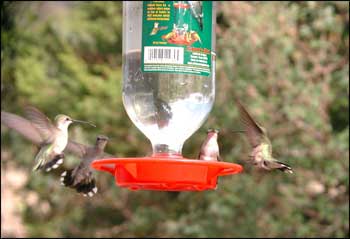
Black-chinned Group at a Feeder
Hummingbird Research Near San Angelo
By Charles Floyd
Various experts have estimated the population of hummingbirds within a short distance from the Hummer House at more than three thousand. Banding efforts have been conducted annually at two other ranches near the Hummer House. One is one half mile distant and the other is a mile distant. Data compared from all three sites suggests that a few hummingbirds travel those distances between sites to feed but a large majority of birds seldom leave their home ranch to feed.
How does a place like the Hummer House come to be? A favorable habitat is important. The ranch surrounding the Hummer House with its scattered oak woodland joining with the oak and pecan trees hugging the banks of the South Concho River offers perfect habitat for these birds. The ranch is home to 256 species of plants with many flowering plants that are attractive to hummingbirds. However, the ranch would not exist as it does today without years of extensive management. There has been a concerted effort over the years to control invasive plants and to foster native wildflowers. Much of the ranch has not been grazed by livestock in many years and where grazing has occurred it has been carefully controlled. Wildlife has also been managed to prevent overgrazing. Much of the ranch exists today as it did generations ago.
Not only does the habitat welcome the hummingbirds, they are welcomed in many ways. Sugar water feeders are in place very early and very late in the season. More than 25 large feeders are in place around the ranch headquarters by mid-summer. These are managed on a daily basis to insure that the sugar water is fresh and to insure that bees and ants are not a problem. Fifteen hundred pounds of sugar is mixed for these feeders during an average season. More than 50 years of consistent feeding has resulted in the current population at the ranch because hummingbirds will return to the same area year after year if they possibly can. Hatching year birds will return to the area where they were hatched to breed and nest. Banding records for the site include the record of a male bird that was originally banded as a hatch year bird at the ranch. When it was recaptured last season, it was nine years old.
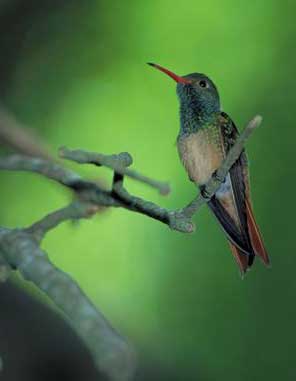
Buff-bellied Hummingbird
Red fabric is always hanging in place as a signal to hummers that they are home. Cotton batting is provided for nest building. The plants that have been added to the yard are always varieties that are attractive to hummingbirds. A water fountain feature is placed near the observation room for hummingbird bathing, socializing and drinking. Many other water sources are available across the ranch. In short, hummingbirds are always welcome.
The Hummer House also has banding records of seven other species of hummingbirds and one additional confirmed sight record of a Broad-billed Hummingbird for a total of nine species of hummingbirds confirmed on the ranch. More than 1400 Ruby-throated Hummingbirds have been banded there along with a few Rufous, Broad-tailed, and Calliope Hummingbirds scattered over the years. Single records exist for Lucifer, Anna's, and Allen's Hummingbirds. Even migrating Black-chinned Hummingbirds stop over as they come and go each spring and fall. It is believed by some researchers that the South Concho River is a flyway that is used by migrating hummingbirds. Perhaps the sound of all the Black-chinned Hummingbirds draws migrating birds to the Hummer House.
Just why these vast numbers of hummingbirds are present at the Hummer House can be debated by experts but the fact remains that they are there. People of all ages come from far and near to marvel at them. During hummingbird season, programs describing their habits and characteristics are presented several times each week. Researchers and bird banders from across the country gather to study these birds. From the observation room, or the porches of the cottages, guests can get up close and personal to these birds from morning until dusk. Deer, turkey and many species of other birds share the ranch with the hummingbirds. In fact, many songbirds inhabit the ranch in very impressive numbers but the ranch continues to be about the hummingbirds.
Charles Floyd is a permitted hummingbird bander who is working at this location near Christoval, Texas.
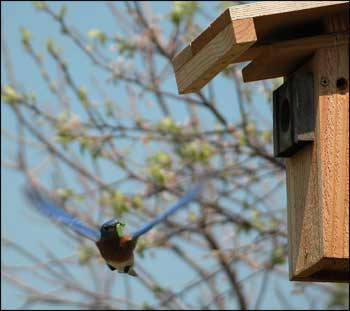 Hill Country Bluebird Trail
Hill Country Bluebird Trail
LeAnn Sharp
All of these small native cavity nesting birds are as interesting and fun to watch as Bluebirds are. They all need cavities to nest in, but none of these birds can make their own hole or cavity in a tree. And because there aren't enough dead trees with cavity holes in them anymore; these cavity nesters need our help too. All native birds are protected by law. Therefore you should not remove their nests from your nestbox until they are finished nesting and their fledglings have left the nest.
Bluebirds can and will build two to four nests each season, sometimes nesting thru July or August. If you have some of these other birds in your nestbox, you could still attract bluebirds after these birds have finished nesting. If you install several nestboxes you could have several species of birds nesting at the same time. Bluebirds are insect and berry eaters, so you won't see them at your seed feeders. They love bird baths, so be sure to furnish fresh water for them to bathe in, and watch the splashing begin.
Weekly monitoring and recording what you find in your nestbox is fun and educational for you, your children and grandchildren. Anyone can monitor nests in nestboxes and trees. It's a rewarding way to spend time outdoors and participate in science through NestWatch; a national citizen-science project and nest-monitoring database of the Cornell Lab of Ornithology.
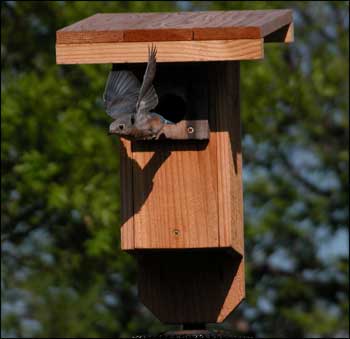
"Be Aware No Tellin' What's in There"! When monitoring and opening our nestboxes I have been surprised by a mouse a few times and once I startled a Golden-fronted Woodpecker, actually we startled each other. I still can't figure out how he squeezed through that small 1/2" hole. Fortunately, I've never opened a nestbox to find a snake, but some people have. Nestboxes in East Texas are a favorite spot for Flying Squirrels to build nests. Since 2006 I have been finding bats in my nestboxes. That's right, bats! Most of the bats I find are cave myotis; a few have been Mexican free-tailed bats. I've found one to ten bats together in one nestbox. So I started monitoring and recording bats I find in the Fall and late Winter. The timing makes me think they are using the nestboxes as resting spots in-between their summer and winter roosting sites during fall and spring migrations. We leave our nestboxes up year around so wintering bluebirds can use them to stay warm if need be. And I was happy to find that we were providing shelter for bats as well. That is until I started finding bats in them in March when the birds were supposed to start building nests. So we put up bat houses, and within two weeks the bats moved into their new shelters. I still find an occasional bat in my bluebird nestboxes, but I just make sure we have plenty of nestboxes up for everyone!
LeAnn has been Vice President of the Texas Bluebird Society for seven years. She and her husband reside near Utopia, TX where they manage a nature tourism based lodge.
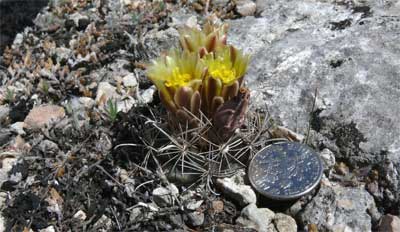 Habitat Cost Assistance Programs
Habitat Cost Assistance Programs
for the Texas Hill Country
By Chuck Kowaleski
First let's look at some of the common habitat practices you might want to do on your property. These could include removing invasive species such as mesquite or cedar, fencing cattle out of creeks to improve water quality and wildlife habitat, installing water sources for stock and wildlife, replacing introduced grass pastures such as Bermuda with native species, planting wildflowers and other pollinator friendly species, trapping and removing cowbirds that are parasitizing song bird nests or just generally improving the quality of your wildlife or livestock operation.
NRCS's Environmental Quality Incentive Program (EQIP) offers the best chance of providing 50% cost share for all of the common habitat practices mentioned above BUT, to qualify for this program the landowner must be an agricultural producer (made or lost money on agriculture over the last 3 years), must need to perform the practice to improve their farm or ranch operation (sorry folks, no stock tanks without stock), water quality and/or quantity and be in a county whose local committee has decided that these are priority practices. Also the applicant must not have made over $1 million in adjusted gross income (AGI) for the preceding 3 years unless at least 66% of it came from farming, ranching or forestry. If you believe you meet these eligibility requirements the next step is to contact your local NRCS office and set up an appointment for someone to visit your property and develop a resource management system plan based on your goals and needs. NRCS offices can be located using the following website:
http://offices.sc.egov.usda.gov/locator/app .
You'll notice that Texas is divided into 3 sections on the map at this website. Choose the section that contains the county your land is located in and when the next page opens up, click on that county. Choose the service center contact information for NRCS from the list provided. Because each county has a limited amount of funding they prioritize their resource concerns so it is also a good idea to find out what your county priorities are by going to this website: http://www.tx.nrcs.usda.gov/programs/EQIP/11/index.html . Once there click on the section of the state map that contains your county, then on the county name from the list that appears. A page with the county priority and ranking system will pop up.
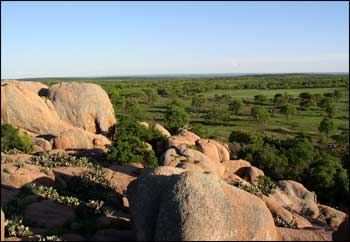
Landowners can signup for EQIP at the NRCS office at any time. When clearing brush in the Hill Country, special care must be taken to avoid damaging the habitat or disturbing 3 listed species - golden cheeked warblers - who need mature cedars mixed with oaks, black capped vireos - who need low scrubby oaks with open areas around them and Tobusch fishhook cactus. NRCS staff will survey your property and design brush management activities to avoid these species habitats and nesting periods. Cost share is also currently available to landowners wishing to improve golden cheek warbler habitat and for those folks that would like to trap and remove brown headed cowbirds that parasitize other songbirds nests. Total removal of brush may be beneficial to a cattle operation but can negatively impact many desirable wildlife species including deer and turkey. Leaving travel corridors and scattered clumps of good browse and mast producing species is very important and should be part of any brush management plan.
NRCS also has a program for landowners interested in improving their wildlife habitat that are not agricultural producers. It is called the Wildlife Habitat Incentive Program (WHIP). All of the practices mentioned earlier as well as many other focused primarily on wildlife habitat can be performed under WHIP. Participants in WHIP must still meet the $1 million AGI limit mentioned above. Funding is more limited than that available under EQIP.
One great way to quickly improve wildlife habitat is to restore riparian areas. Livestock tend to gather along watercourses to take advantage of shade and lush vegetation. This not only damages high quality wildlife habitat and travel corridors but increases erosion and lowers water quality. FSA provides cost share and an annual rental payment for 10-15 years for restoring damaged and overgrazed areas in pastures along creeks and other waterways. Generally this consists of cost sharing the fencing to exclude livestock from these areas as well as providing a replacement water source if needed. Grazing within the protected area is prohibited for the life of the contract. FSA can be contacted using the websites mentioned for locating local NRCS offices. NRCS has a similar practice that allows periodic grazing but does not provide the annual rental payment.
Fish and Wildlife Service's Partners for Wildlife and Texas Parks and Wildlife’s Landowner Incentive Programs (LIP) can also provide landowners with up to 75% cost share and free technical assistance and are typically focused on federally protected and at-risk species and their habitats. Information on the Partners for Wildlife Program can be located at: http://www.fws.gov/southwest/es/arlingtontexas/pdf/PFW%20Fact%20Sheet.pdf . Most of the Hill Country is handled by the Central Texas office in Austin. Information on TPWD's LIP program is located at the following website: http://www.tpwd.state.tx.us/landwater/land/private/lip/.
These programs can provide needed technical assistance as well as help stretch habitat improvement dollars. Interested folks should know that they generally require landowners to pay for the practices up front and then receive reimbursement based upon set rates. Practices must also meet established specifications to receive reimbursement and require landowners to maintain them for a certain period of time.
Chuck Kowaleski is Texas Parks and Wildlife Department's Farm Bill Coordinator working out of Salado, TX.
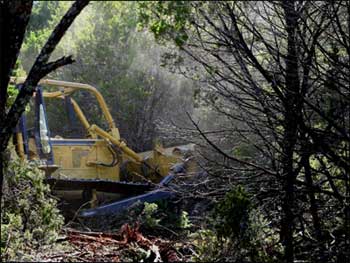 Agricultural Tax Appraisal
Agricultural Tax Appraisal
Based on Wildlife Management Use
By Linda Campbell
Implementing wildlife management as an agricultural use to qualify for the 1-d-1 Open Space Agricultural tax appraisal in Texas is still confusing to many landowners. Under Texas law wildlife management is a qualified agricultural use for the purposes of ad valorem (property) taxes. Lands approved for wildlife use pay the same amount of taxes as those appraised for other agricultural uses.
While it is relatively easy to switch from traditional agricultural uses such cattle or hay production to wildlife management, there are guidelines that must be followed in order for the property to receive the agriculture tax appraisal based on wildlife management use. Landowners qualify for this tax appraisal if they meet the following criteria:
- The property must already be qualified as 1-d-1 Open-Space Agricultural Use land before it is eligible to change to wildlife management.
- The primary use of the land must be for managing wildlife.
- An application for 1-d-1 (Open-Space) Agricultural Appraisal showing the change in land use over to wildlife management must be submitted to the Central Appraisal District in the county in which the property is located.
- A wildlife management plan must also be completed and submitted along with the application. Both these forms should be submitted between January 1 and April 30 of the year in which the change in land use is to take place.
- If the property has been reduced in size since the previous tax year, minimum acreage requirements must be met to qualify for wildlife management.
The law requires that landowners conduct specific management practices designed to enhance the target wildlife species. The wildlife management plan needs to address at least three of the following seven management practices to be performed each year.
- Habitat Control
- Erosion Control
- Predator Control
- Supplemental Food
- Supplemental Shelter
- Supplement Water
- Conducting Census
Minimum acreage size is likely the most confusing item when switching from traditional agricultural use to wildlife management. Essentially, minimum acreages apply only when the size of the tract of land has changed from the previous tax year. Because these minimum acreages vary by county and ecoregion, interested landowners should contact their central appraisal district for the minimum acreage requirements in their county.
For additional information regarding wildlife management as a qualifying open-space agricultural use, contact your local appraisal district, Texas Parks and Wildlife Department, or the Texas AgriLife Extension Service.
Helpful Links:
www.tpwd.state.tx.us/taxvaluation
https://agrilifebookstore.org/publications_details.cfm?whichpublication=2838 (SP377)
Linda is the Private Lands and Public Hunting Program Director for Texas Parks and Wildlife Department working out of Austin.
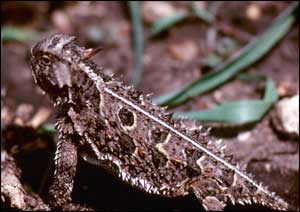 Wildlife Management and Research
Wildlife Management and Research
at the Pantex Nuclear Weapons Facility
Embracing National Security, Native Habitat, and Wildlife
By Jim Ray
The Pantex Plant is a facility within the U.S. Department of Energy / National Nuclear Security Administration (DOE/NNSA) complex, and encompasses an area of more than 18,000 acres. Sitting atop the Southern High Plains of Texas near Amarillo, the mission area of the facility is surrounded by acreage of shortgrass prairie, grasses enrolled in the Conservation Reserve Program, and cultivated agriculture – a look that is very similar to the surrounding landscape.
Agency and Presidential directives support natural resource management, and its staff manages natural resources through six plans dealing with land management and wildlife. The Plant's Agronomist, Monty Schoenhals, spear-headed the development of the "Water Quality Management Plan for Pantex", which is a state-certified soil, water, crops, and wildlife conservation document that wraps all the other plans up into a single, integrated conservation document. Another plan, "The Integrated Plan for Playa Management," also has links to the other documents, but caters even more to wildlife management.
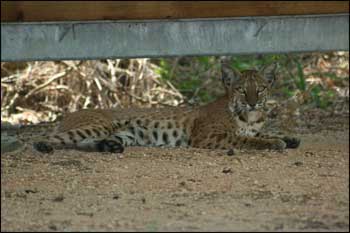
© Kathleen Miller
Scattered across Pantex are six playas, and blocks of shortgrass prairie, the High Plains' primary habitats for wildlife. These, and species of concern, are the focus of wildlife management and research activities on the facility. Habitat management includes native grassland buffers surrounding playas, restoration of native prairie utilizing species specific to soil type, and management of shortgrass prairie through rotational grazing and prescribed fire. The neighboring Texas Tech Research Farm, which is leased by Pantex as a security buffer, has been so impressed with the Pantex grazing prescription's affects on livestock and wildlife, that they have implemented the prescription on that property.
Research at Pantex has focused on black-tailed prairie dog, macroinvertebrate, and herpetological communities; effects of wind energy development on wildlife; and other site-specific needs that arise. Black-tailed prairie dog colonies provide important diversity to the shortgrass prairie habitat in the Great Plains. Colonies at Pantex have been mapped on an annual basis since 1997, demonstrating how colony boundaries fluctuate through time, and colonies are self-regulating when grazing or mowing pressure is kept on the conservative side. Prairie dogs occur on 350 acres of Pantex, and this acreage is scattered across six relatively small colonies.
Pantex has developed a great relationship with universities, cooperating recently with West Texas A&M University (Canyon), Texas Tech University (Lubbock), and the Texas Cooperative Fish and Wildlife Research Unit (U.S. Geological Survey/Texas Tech University) located at Texas Tech. Since 1999, Pantex wildlife work has been published through nine manuscripts in the scientific literature, and presented at 22 professional meetings. Studies included:
- 2000 - 2001: Pantex and West Texas A&M University conducted research on macroinvertebrate diversity among different habitat types on Pantex. (D. Sissom and students; J. Ray [B&W Pantex].)
- 2000 - 2005: Pantex and Texas Tech University conducted research on the wildlife community differences among prairie dog colonies, controlled prairie dog colonies, and shortgrass prairie not containing prairie dogs; association of prairie dogs with playas; and development of a new technique for surveying prairie dogs. They also looked at burrowing owl ecology, and impacts of necklace radio-transmitters on burrowing owls. (M. Wallace, W. Ballard, C. Boal, N. McIntyre, K. Schmidt, R. Strauss, and students ; H. Whitlaw [TPWD], J. Ray and M. Schoenhals [B&W Pantex].)
- 2003 - Present: Pantex and West Texas A&M University conducted research on amphibian and reptile communities at Pantex, including focus on the state threatened Texas horned lizard, and the prairie rattlesnake. (R. Kazmaier and students; J. Ray [B&W Pantex].)
- 2009 - Present: Pantex and West Texas A&M University conducted pre-monitoring associated with proposed wind energy development. (R. Matlack and students; J. Ray [B&W Pantex].)
- 2009 - Present: Pantex and West Texas A&M University initiated satellite-tracking of a population of bobcats living in the non-traditional habitat on and surrounding the facility. (R. Matlack and students; J. Ray [B&W Pantex].)
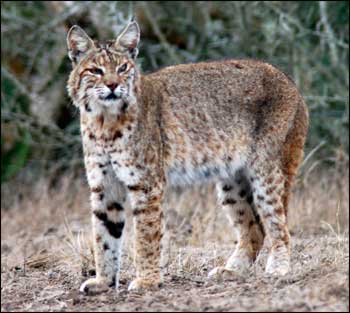
Pantex deals with wildlife issues as proactively as possible, and this has not gone unnoticed. In conjunction with National Raptor Month, Xcel Energy's Southwestern Public Service Company (SPS) recognized Pantex in October for its proactive move to protect birds-of-prey through installation of devices on 500 new utility poles that provide the birds protection from electrocution. This came about as a result of the pre-project review, required by the National Environmental Policy Act. All new projects are reviewed for impacts to wildlife (and other disciplines). Pantex is also frequently asked to participate on committees and working groups dealing with regional wildlife issues.
Care for the environment is a major component associated with the operation of facilities within the DOE/NNSA Complex. Thriving wildlife, and proactive research, planning, and management are all testimony to the commitment to the environment being shown by Pantex on the Texas High Plains.
Jim Ray retired from Texas Parks and Wildlife to work with the Pantex facility in the Texas panhandle.
Humming in the Texas Hill Country
By Mark Klym
Black-chinned Hummingbirds are by far the most common bird seen in this region. Abundant from mid March to early August, Black-chins are being reported quite frequently as year round birds in recent years. Other hummingbirds that occur in good seasonal numbers include Ruby-throated Hummingbirds which is uncommon from early August to October and rare in the spring from mid March to early May, the Rufous Hummingbird uncommon late July to early November and rare to accidental to early April, the Broad-tailed Hummingbird rare from late July to early November and accidental through May, the Calliope Hummingbird late July through April, and the Green Violet-ear mid May through mid September. So, Black-chinned Hummingbirds are far from the only hummingbird species likely in central Texas.

Rarer in the area are such species as Broad-billed Hummingbird, White-eared Hummingbird, Buff-bellied Hummingbird, Blue-throated Hummingbird, Lucifer Hummingbird, Anna's Hummingbird and Costa's Hummingbird. Until this past season when a Green-breasted Mango was photographed in Dripping Springs, the Violet-crowned Hummingbird was probably the rarest hummingbird recorded in the Hill Country.
I have not discussed the Allen's Hummingbird, because this bird is probably much more common than published checklists indicate. Research is indicating that birds once considered "green backed Rufous" are more likely to be Allen's Hummingbirds.
So, how do we make it more likely that we will see something other than the abundant and uncommon birds? The most important factor in looking for any wildlife is habitat. For hummingbirds, as for any other wildlife, this includes food, shelter and water. Food and water are similar for most hummingbirds, although there are some plant/bird relationships that make a bird more likely to appear at one plant than another. For example, Blue-throated Hummingbirds are more likely to occur at penstemon plants than at huisache - which is more likely to attract Buff-bellied Hummingbirds. Water is consistent in all species, but the real difference occurs with the shelter.
Those who read the spring newsletter online will recall that Dr. Brent Ortego reported some results from his multi-year winter hummingbird study at Raisin, TX. The use of the various habitats by different bird species was quite distinct in all species except the Buff-bellied. This tells me that the more diversity we can develop - not just diversity in species but diversity in plant communities and community structure - the more likely we are to see diversity in our hummingbird species. This is born out when you visit "hummingbird hotspots" across the south west - the spots you remember because of the diversity you see are invariably those with multiple habitat types.
As we approach another hummingbird season, I encourage you to enhance your hummingbird gardens by creating diversity. I would also urge you to participate in monitoring projects like the Hummingbird Roundup to help us understand more about hummingbirds and how they use habitat features across Texas.
Mark Klym is coordinator of the Texas Hummingbird Roundup and works out of TPWDs Austin headquarters.
Getting Kids Outdoors
Through the Texas Youth Hunting Program
By Linda Campbell
The Cave Creek hunt is one of 140 TYHP hunts around the state that provide opportunities for nearly 1000 youth, along with numerous siblings and family members, to experience the outdoors, learn about wildlife, and spend quality time together. Since 1996, the Texas Wildlife Association (TWA) and Texas Parks and Wildlife Department (TPWD) have joined forces to offer safe, educational and affordable youth hunts through TYHP. Throughout the state, TPWD field biologists and game wardens participate by teaching youth and their parents about wildlife management, hunting regulations, safety and ethics. A number of TPWD employees also serve as Huntmasters to organize and conduct hunts for TYHP.
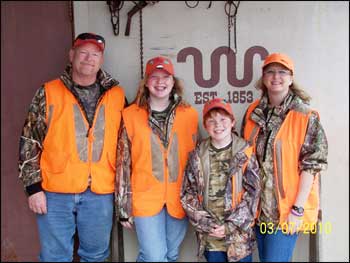
Landowners who generously open their gates to TYHP and Huntmasters willing to share their time and passion for wildlife and hunting with kids provide the backbone of TYHP. Both receive the personal satisfaction of knowing they have contributed to the future of hunting by providing the opportunity for kids and their parents to experience the lasting memories that come with their first hunt. Dedicated volunteers, who organize paperwork, buy groceries and cook meals, and teach everything from marksmanship to sausage making are key to ensuring enjoyable outdoor experiences for participants and their families.
On TYHP hunts, youth hunters understand that while they are having fun, they can also help manage wildlife by assisting private landowners in accomplishing their management goals. Managing high densities of deer and exotic ungulates is often a challenge for landowners who want to maximize native wildlife and plant diversity. If you are a landowner working to achieve your harvest goals, please consider supporting the next generation of hunters by offering a hunt to TYHP. The program provides liability insurance and runs safe, mentored, educational youth hunts. Landowners can be as involved as they want to be. TYHP just needs a place for at least four youth to hunt safely and volunteers will manage the logistics, regardless of the facilities. The program needs all types of year-round hunts and can assist you in achieving your wildlife management goals.
For more information about the Texas Youth Hunting Program, please visit
www.texasyouthhunting.com .
Linda Campbell is the Private Lands and Public Hunting Program Leader at Texas Parks and Wildlife Department working out of Austin.

 Texas Parks and Wildlife Department, 4200 Smith School Road, Austin, TX 78744
Texas Parks and Wildlife Department, 4200 Smith School Road, Austin, TX 78744


